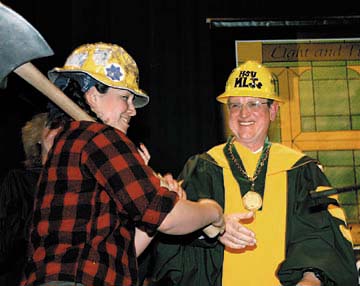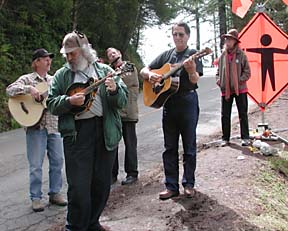|
May 8, 2003
Innovation, creativity shine in waste reduction effortsIf you think waste management is a less-than-scintillating topic, consider the stories behind this year's Waste Reduction Awards, presented April 24 by the Humboldt County Division of Environmental Health. The efforts of individual companies, nonprofits and government agencies to reduce the amount of stuff they send to a landfill reveals a surprising amount of energy and creativity -- as well as a genuine concern for the environment. Here are some of the awards: BEST BUSINESS WASTE REDUCTION EFFORT: Tofu Shop, Arcata Matthew Schmit In addition to recycling everything from paper to cheesecloth, the 15-employee Tofu Shop gives its soybean pulp, a by-product of making tofu, to local farmers. That alone has allowed the shop to divert 240,000 pounds of pulp per year. As a result of their extensive recycling program, the Tofu Shop puts out just one 32-gallon trash can per week -- as much as many small families. BEST BUSINESS WASTE PREVENTION EFFORT: 321 Coffee, Eureka Steve Palmer Since day one, 321 Coffee in Old Town Eureka has never offered to-go containers and has recycled everything the recycling center would accept. All food waste was composted until recently, although they are currently working on establishing a new composting set-up. "Every day I turn business away because I refuse to have paper or foam or even more recyclable forms of to-go cups. I hate single-use items," said owner Steve Palmer. "I run my business this way because I did not want to make a buck at the expense of fouling the planet." MOST EFFECTIVE WASTE PREVENTION EFFORT: Black Oak General Contracting Chris Callahan Back in 1998 Black Oak Contracting owner Gene Callahan had a revelation while supervising a roof tear-off of a local church. As he saw the pile of old cedar-roofing shingles grow, he realized that these could potentially be put to use in another project as siding. Not only were the shingles in good condition, but Callahan admired their weathered patina and texture and thought it had a unique rustic charm. Most importantly to Callahan, it "would be a colossal waste and a shame to send a couple tons of usable wood to the landfill." Since that time, several local construction projects have provided cedar roof shingles for reuse, and Black Oak General Contracting has completed six two-story homes, six outbuildings and one church. MOST EFFECTIVE RECYCLING/REUSE EFFORT: Gas Stoves with Style, Eureka Bob & Marilyn Schultz This company's goal is to keep as many gas-cooking stoves out of the landfill as possible by prolonging their useful life through repair and regular maintenance. The average life span of a new stove is merely five to 10 years, with trade magazines stating eight. With every 50-year-old stove that Gas Stoves with Style is able to renovate, they save approximately six stoves from going to the landfill because, with minimum care, these stoves will last another 50 years. Gas Stoves with Style also acts as a volunteer clearinghouse linking sellers of stoves with buyers. MOST EFFECTIVE COMPOSTING PROGRAM: Recyclist, Arcata Shane Kellar & Potawot United Indian Health Village Shane Kellar, owner and founder of Recyclist, started the pedal-powered delivery service over three years ago in Arcata. As one aspect of Recyclist, Kellar and his team began hauling food scraps from local restaurants to local organic farms for composting. Almost two years ago Kellar teamed up with the United Indian Health Village (UIHS) Potawot Village, also in Arcata. Every few days Kellar picks up food waste from specific restaurants and delivers it to Potawot for their composting program. In 2002, Recyclist was able to transport over 15 tons of food waste from restaurants to Potawot for composting. The material is then used in their organic vegetable garden. The food from the 1-acre garden feeds people at the clinic and in the United Indian Health Village community. MOST EFFECTIVE USE OF REUSED MATERIALS IN MANUFACTURING: Bayside Drywall, Eureka Doug Lantelme Through Doug Lantelme's work as a licensed drywall contractor, he has seen a lot of drywall head to the landfill. The construction of a single-family home can alone produce more than one ton of drywall. In 1996 Lantelme started doing research into gypsum drywall, which is primarily comprised of calcium sulfate. Faced with paying $78 a ton for disposal of this material, he found that it could have other uses when broken up into small pieces and sifted so the paper is removed. "I've found ranchers and farmers who want to apply it directly to their pastures. Commercial flower-growing operations value gypsum as a soil amendment." MOST EFFECTIVE SCHOOL WASTE REDUCTION PROGRAM: Manila Bicycle Project Hillarie Harless & Peter Robinson The project teaches youth ages 14 through 21 to fix discarded and donated bicycles and then helps the youth run the business of selling the repaired bikes. Grisman and the Jerry tree
Grisman was there to give a private concert for Freshwater treesitters the morning after a performance at Humboldt State University. Nearby stood the giant redwood known as "Jerry" (named in honor of you-know-who), occupied by Remedy for just short of a year before she was forcibly removed last month and arrested for trespassing. A treesitter known as Huckleberry is currently in the tree. Earth First! activist Darryl Cherney used the occasion to announce a campaign to purchase "Jerry" from the Pacific Lumber Co., a plan modeled on the purchase of "Luna," the redwood Julia Butterfly Hill occupied for two years in the late 1990s. Cherney said seed money is coming from the Rex Foundation, the philanthropic arm of the Grateful Dead. "It's the Jerry tree so we thought why not call the Grateful Dead people and see if they might help," he explained. When Cherney called Bob Barsotti of the Rex Foundation, Barsotti said he thought the foundation could provide $5,000 toward the acquisition. The money will be held by the Trees Foundation, a Southern Humboldt-based outfit that serves as an umbrella for a number of forest protection groups. "Just as Luna is a symbol, Jerry is a symbol," Cherney said. "We're looking for symbols of peace, something to rally around. This tree can bring people together." The redwood is currently marked for cutting as part of a timber harvest plan that has already sent many of the trees occupied by protesters to the mill. HSU Presidential Inauguration
Humboldt State University President
Rollin Richmond with Christina Velasquez, "axe major"
of the Humboldt State University Marching Lumberjacks, at Richmond's
inaugural last week. Velasquez presented Richmond with the hard
hat, which he wore to a reception following the ceremony at the
Van Duzer Theatre. Daly buildings resoldTwo of the three Daly buildings in downtown Eureka have been resold just three weeks after the entire complex was purchased from Humboldt State University by businessman Rob Arkley and his wife, Cherie Arkley, for $325,000. Developer Steve Strombeck, who declined to release the purchase price, said he expected escrow to close Wednesday and he hopes to break ground in just four to five weeks. "I already have had plans into the city. We expect to go to [the] Design Review [Committee] next week," he said. The Arkleys are retaining ownership of the historic State Theater, known as the Sweasey. They estimate it will take $1 million to $2 million to restore it into a performing arts center before it will be given to a nonprofit to operate. Strombeck would not confirm that his potential tenant is the new Redwood Capital Bank, where he sits on the board. "I don't have a lease yet. I expect to make an announcement when we break ground," he added. Strombeck said he and his wife, Tina Strombeck, wanted to thank the Arkleys, "primarily for selling [us] the building, but most of all for putting so much effort into seeing needed projects get done in Eureka." New judge wantedAttorneys for the anti-logging protesters who were pepper-sprayed by police and sheriff's deputies in 1997 filed a motion this week in federal appeals court to dismiss the judge on the case and move the trial back to San Francisco. If the motion is denied, jury selection in the excessive force trial will begin as scheduled on Monday in federal district court in Eureka, with Judge Vaughn Walker presiding. (The courtroom is room 205A on the second floor of the post office at Fifth and H streets.) The nine activists sued the county and the city after their eyes were rubbed with pepper spray during sit-ins at Pacific Lumber's Scotia headquarters and the office of then-Rep. Frank Riggs. An earlier motion to recuse Walker from the case was denied late last month. Walker threw out the case last year after the jury deadlocked, but a federal appeals court ordered it to be retried. Walker then decided it should be moved from San Francisco to Eureka. "The judge is biased, and one of the manifestations of his bias is that he has moved the trial from a neutral location to a location where there is considerable community hostility toward environmental activists," said Robert Bloom, one of the plaintiffs' attorneys. The size of the federal courtroom in Eureka may be a challenge in itself. "It's a small courtroom, small jury box, small everything," said Jim Gilmore, chief deputy clerk of the U.S. District Court in San Francisco. "It's gonna be crowded, to put it mildly." Man killed in BridgevilleA Bridgeville man was shot to death Sunday night by a suspect who entered a downtown house asking if it was for sale, the Humboldt County Sheriff's Office reported. Joey Church, 34, was killed in the shooting shortly after 8 p.m. Sunday, and another unidentified victim was injured. The suspect, described as a man between 30 and 40 years of age, about 5 feet 10 to 6 feet tall, 180 pounds, with long blond hair and a Fu Manchu-style mustache, left the scene. Witnesses said he was driving a gold sedan of unknown make. The shooter reportedly opened fire after being told twice that the town of Bridgeville -- not Church's house -- was for sale. Bridgeville attracted considerable media attention when it was sold on eBay for nearly $1.78 million in December, though that sale has not yet closed. Anyone with information about the case is urged to call the Sheriff's Department at 445-7251. 150 and countingHumboldt County, formed on May 12, 1853, by the California Legislature, will turn 150 next Monday. In anticipation of the sesquicentennial, Supervisor Roger Rodoni on Tuesday read a proclamation into the record celebrating this "historic and momentous occasion." It was a dramatic, if gruff, performance. "They got the historic, how do I put this, the old guy to do it," the silver-goateed Rodoni said as he presented a copy of the proclamation to a representative from the Humboldt County Historical Society. Some historic moments in the last 150 years: December 20, 1857: The first lighthouse on the North Coast goes into operation. It is located on the North Spit of Humboldt Bay. 1914: Northwestern Pacific Railroad completed, connecting Eureka with San Rafael. 1918: Dayton Murray makes the first airplane flight from Eureka to San Francisco. 1941: Tanker "Emidio" sunk by Japanese submarine off Cape Mendocino. COVER STORY | PUBLISHER | CALENDAR Comments? © Copyright 2003, North Coast Journal, Inc. |
||


 Master
mandolin player David Grisman, a long time associate of the late
Grateful Dead guitarist Jerry Garcia, did his stuff along Greenwood
Heights Road last week with three members of his band. Looking
on was former tree sitter Jeny Card, aka Remedy.
Master
mandolin player David Grisman, a long time associate of the late
Grateful Dead guitarist Jerry Garcia, did his stuff along Greenwood
Heights Road last week with three members of his band. Looking
on was former tree sitter Jeny Card, aka Remedy.